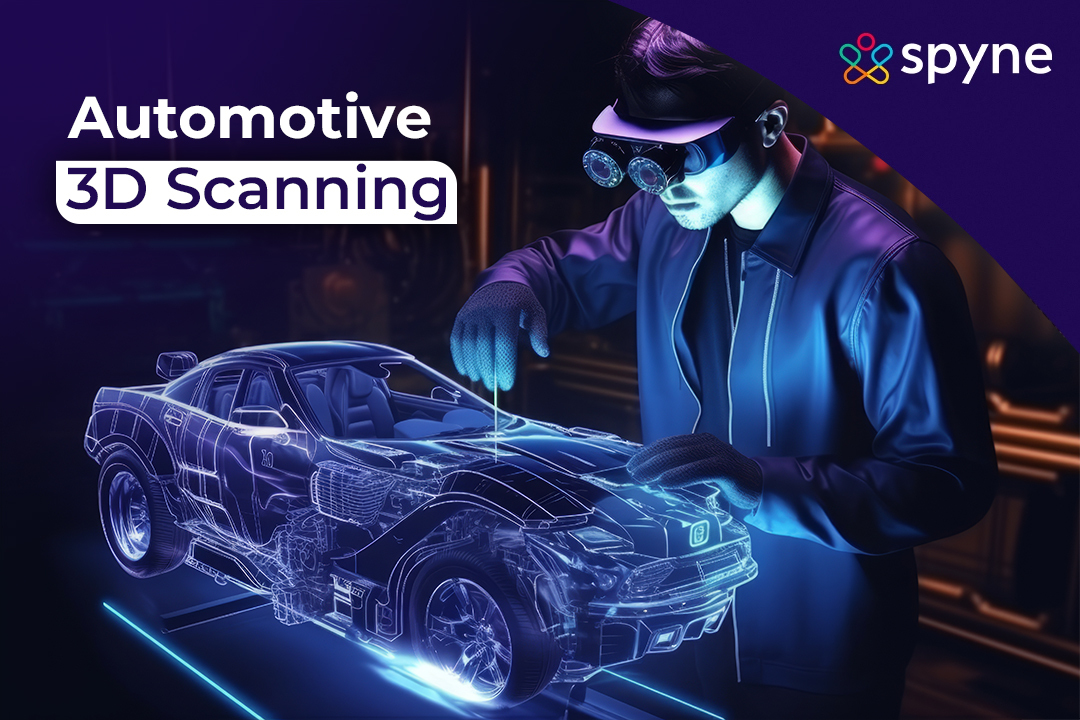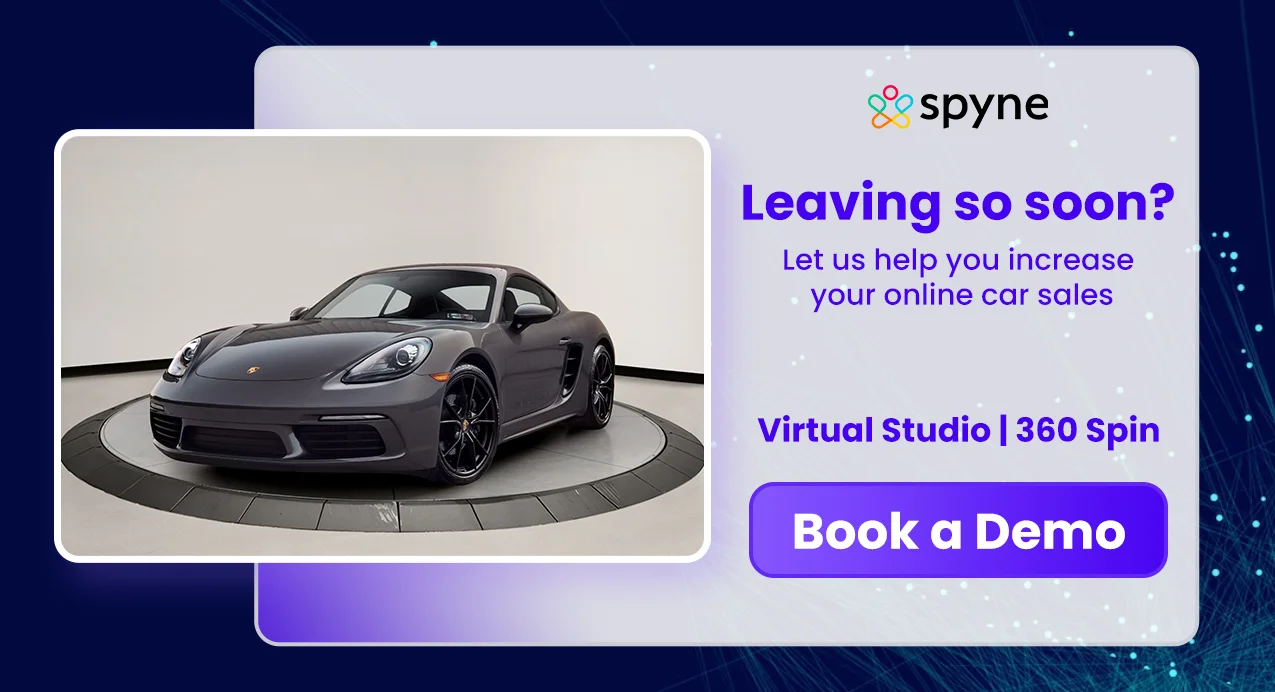The automotive industry is expanding! Be it the rise of limitless customization or crazy modifications in the thriving second-hand market, we will see more technologies and innovations guide the course of change as the industry grows. One such innovation is automotive 3D scanning, a process revolutionizing car design, production, and quality control practices within car dealerships, car manufacturers, and custom shops. Although 3D scanners are widely used in different industries, their impact on the automotive business makes it possible to achieve precision, speed, and cost efficiency. This article focuses on the significance of 3D scanners for cars, the kinds of scanners available in the market, their usage in the industry, and how Spyne’s 3D scanning solutions can help your automobile dealership business.
What is Automotive 3D Scanning?
Automotive 3D Scanning is a technology that generates accurate digital models of physical objects, such as car parts, by accurately catching details on the surface. In this process, 3D models can be used for design, reverse engineering, quality control, and rapid prototyping. These automotive 3D scanning works by emitting laser beams or capturing multiple photographs from different angles using structured light and then reconstructing the collected data into a virtual model.

The Various Kinds of 3D Scanners
A number of different types of 3D scanning solutions exist, each having its unique advantages based on the application. These include:
Laser Scanning
Laser scanning involves the projection of a laser beam onto the targeted vehicle and recording the anomalies it undergoes while interacting with the car surface. There are mainly two types of laser scanning:
1) Laser Triangulation: It uses one laser and multi-card cameras to capture the shape of any object with high resolution.
2) Time of Flight: In this, the scanner measures the time it takes for the laser beam to return to the sensor; therefore, it gives distance values from the object
Structured Light Scanning
Structured light scans are similar to those in laser triangulation but use light patterns instead of lasers. A projector projects a certain pattern on the object, and cameras capture the deformations on the pattern to calculate the 3D model.
Photogrammetry
Also the most popular, this method takes several 2D photographs from different angles. Using software, images are combined to recreate a 3D model. Although photogrammetry can capture colors and textures, it requires the scale tool to be present in the image to retrieve the object’s size.
Why Is 3D Scanning Important for Car Dealerships?
Some of the major benefits that dealerships witness in the process of using 3D Scanning Services include optimizing business operations, increasing customization capabilities, and enhancing customer experience. Well, the benefits do not end here. Here are more:
Quality Control
One main advantage offered by custom 3D rendering or scanning is with respect to cross-checking the scanned digital model with the original CAD model so that parts may be verified with the required specifications. The level of accuracy has to be kept intact in manufacturing and assembly work as per quality standards.
Reverse Engineering
For parts that do not have available CAD files or custom parts that need to be altered, a professional 3D scanner will enable dealerships to capture complex geometries accurately. This method eliminates the guesswork of manual measurements, which speeds up the prototyping process.
Streamlined Prototyping
By scanning physical parts, dealerships can change and improve designs digitally and create physical versions of the same. In other words, many iterations of design and modifications can be tested quickly on digital models without having to produce costly prototypes of each rendition.
Shorter Design Cycle
With a 3D scanner, the car body can be captured easily and used for designing. This drastically cuts the time involved in building proportions and canvases of the car. It speeds up design, prototyping, and manufacturing stages, allowing for more rapid time-to-market for newer models or variations.
Measurement Needs
Whether it’s a complex component with intricate details or hard-to-reach areas, 3D scanning can accurately measure every piece. This becomes a big advantage when dealing with one-of-a-kind parts or legacy components.
Cost Savings
Dealerships can use 3D scanners to reduce the number of full-scale prototypes needed, which decreases material costs and the risk of errors in production. Additionally, testing virtually can also save costly mistakes before pre-production levels.
How Is 3D Scanning Applied in the Automotive World?
Automotive 3D scanning softwares is becoming more important in the automotive world. Bridging the gaps between physical and digital worlds helps the industry achieve more precise design, manufacturing, and quality control. Here’s how 3D scanning is used for cars:
Reverse Engineering
Car parts without original documentation can be scanned and transformed into high-quality CAD models, which can be used further for analysis or for designing new parts.
Inspection and Quality Control
3D scanning allows for the fast comparison between the manufactured parts and the original CAD design. This may indicate defects, deviations, or imperfections in the parts created that could affect the vehicle’s performance.
Rapid Prototyping
A part scanned with 3D scanning can be used to generate prototypes in no time. Whether it’s the interior or the exterior of the car, 3D scanning helps manufacturers reduce the time taken by the prototyping phase, thus reducing the time to market and finally achieving a quality product.
3D Visualisation
Using a 3D scan of a car with a phone, car dealerships can create an immersive virtual model of their fleet of cars. Furthermore, these virtual cars can be reviewed by customers from the comfort of their homes, giving them more convenience to check out the details before the purchase.
Virtual Simulations
A 3D mobile scanner can scan and analyze a virtual simulation at a very detailed level, such as motion analysis, assembly processes, or even crash simulations. Hence, optimizations on designs based on how parts fit and perform in real conditions are enhanced.
Digital Archive
Dealerships and manufacturers can digitize every part, tool, and equipment used in vehicle manufacturing using digital scanning so that their entire product range can be easier to access and preserve for long periods.
Advantages of 3D Scanning within Automotive
Free automotive 3D scanning opens up a host of benefits for almost all stakeholders, including dealerships, buyers, mechanics, etc. Here are some of the top benefits of choosing the best 3D scanner for the automotive industry:
Time Savings for the Production Process
3D scanning can save the time taken by the production process to perform measurements, handiwork, and prototyping in physical form. By using 3D scanning during design, prototyping, and quality control, most areas can be automated.
Reduced Design Cycles
The traditional method of measuring parts is time-consuming and prone to mistakes. 3D scanning provides quicker and more accurate measurements, thus cutting down on design cycles. Additionally, adjustments can take place faster through digital models.
Improvement in Quality
The scanning resolution can identify any flaws and imperfections present in components, resulting in higher-quality products with a lesser chance of defects in the final product.
Portable & Easy-to-use
Many current 3D scanners are mobile and user-friendly, allowing for fast and flexible measurements, even on the production floor. This means minimized interference in operations.
Training Required
Some of the best 3D scanners for automotive can be operated with minimal training. Thus, teams can easily familiarise themselves with scanning technology without requiring technical expertise.
Limitations and Challenges of 3D Scanning
3D scanning has various advantages, but certain challenges are associated with it. Automotive players need to consider these risks before leveraging the technology. Below are these limitations:
Cost
It is quite a heavy investment to invest in excellent quality 3D scanners, especially if one wants to scan high-precision items, such as in dealerships or manufacturers. Furthermore, having different types of scanners for various kinds of components can increase the automotive 3D scanning cost.
Surface Finish
Three-dimensional scanners are often susceptible to very bright, transparent, and too-dark surfaces. To enhance the scanning outcome, special spraying liquids are often used on the surface.
Data Processing
Best Automotive 3D scanning requires a huge amount of memory to store those enormous file outputs from high-resolution scans. This might mean more storage capacities and processing systems will be necessary.
Integration Challenges
It demands some time for adaptation as integration of 3D scanning into current workflows. Perhaps, some time needs to be devoted to get adapted to technology, and transitioning from the traditional to digital scanning can be a steep learning curve.
Trends and Innovations in Automotive 3D Scanning
The landscape of 3D scanning is transforming day by day, embracing numerous emerging trends that shape the industry and its future:
Better Precision: Recent developments in scanning technology are aimed at enhancing accuracy to create much more accurate digital car parts models.
Automation: Automated 3D scanning systems have the ability to speed up processes, thus allowing fewer human interventions and saving time in the quality inspections.
Artificial Intelligence (AI): Artificial Intelligence can be used in the 3D scanning system to remove the errors in scan data and enhance the overall scanning process.
Cloud-Based Solutions: Cloud technology allows easier sharing of 3D scans across teams, thus remote collaboration and better data management.
CT Scanning: CT scanning is becoming increasingly accessible where detailed insights into the internal part structures can be determined. This will be very useful for high-precision parts in the automotive world.
Spyne: The Best 3D Scanning Solution for Car Dealerships
Spyne’s 3D scanning solutions will serve the needs of the modern car dealerships. Coupled with rapid data collection, high definition, and minimal training requirements, Spyne’s mobile scanners enable dealerships in efficient operations, cost reduction, and customer satisfaction. Dealerships can benefit from full-field data collection, faster measurements and intuitive reporting by simply replacing traditional gauges with Spyne.
Comparison of Traditional Gauge with Spyne’s 3D Scanner
| Traditional Gauge | Spyne’s 3D Scanner |
| Limited data collection | Full-field data collection |
| Non-repeatable measurements | Immune to plant floor vibrations |
| Time-consuming | Fast measurement and calculation |
| High setup time | Effortless scanning with no need for setup |
| Requires specialized training | Easy to use, even for first-time users |
Conclusion
Car dealerships looking to stay ahead must invest in 3D scanning technology. Whether the need is for quality control, prototype development, or even the improvement of the customer experience, it is clear that the benefits in 3D scanning are indispensable. With Spyne’s advanced 3D scanning solutions, dealerships can provide all the capabilities to reshape their operations into more efficient ones, providing greater customer satisfaction.



























